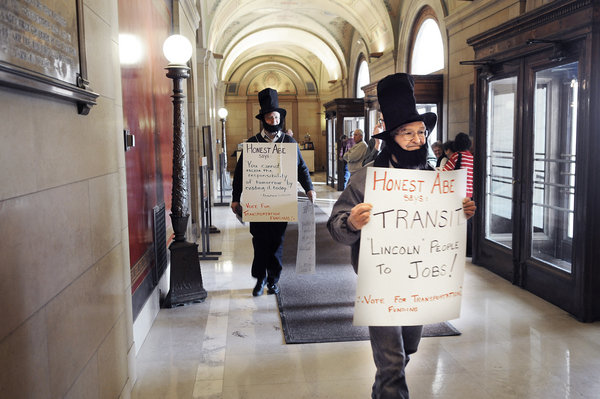At Issue: Driving a new plan
By Mike Cook
It hasn’t taken long to get the wheels turning on a new transportation funding package.
Sponsored by Rep. Bernie Lieder (DFL-Crookston), HF2800 is similar to the one vetoed last year by Gov. Tim Pawlenty, but also contains some bonding aspects that aim to quickly fix some of Minnesota’s estimated $2.4 billion backlog of deteriorating roads and bridges.
 Introduced Feb. 12, the bill was approved one day later by the House Transportation Finance Division on a 12-5 party-line vote, and has stops scheduled in the House Capital Investment, Finance, Taxes and Ways and Means committees by Feb. 19.
Introduced Feb. 12, the bill was approved one day later by the House Transportation Finance Division on a 12-5 party-line vote, and has stops scheduled in the House Capital Investment, Finance, Taxes and Ways and Means committees by Feb. 19.
A companion bill, SF2521, sponsored by Sen. Steve Murphy (DFL-Red Wing), is also on the fast track. The Senate Transportation Budget and Policy Division heard the proposal for a second time on Valentine’s Day.
Lieder and Murphy said the proposal doubles as an economic stimulus package because it would create an estimated 33,000 jobs with good wages and benefits in each of the next five years.
The bill, anticipated to raise $8.3 billion in the next decade, calls for a 2-cent gas tax increase on the first day of the month after enactment and another 3-cent bump on Sept. 15, 2008. Taxes on all other fuels would be raised proportionally. The gas tax, which has not been raised since 1988, would also be indexed to inflation, with an annual update beginning Sept. 15, 2010.
According to Lieder, a person who drives 11,000 miles a year, at an average of 20 miles per gallon, would pay an extra $42 per year.
A $25 tax credit would be created for lower income people to help offset the increase.
In addition, the bill calls for an increase in vehicle tab fees and removal of tab fee caps instituted by former Gov. Jesse Ventura. However, the change only takes effect once a new vehicle is purchased. The minimum fee would remain at $35.
“This bill relies on user fees, which is a fair system for funding transportation,” said Margaret Donahoe, legislative director of The Minnesota Transportation Alliance. “Those who use the system, pay for the system.”
Residents in the seven-county Twin Cities metropolitan area could be subject to a 0.5 percent sales tax increase without a referendum, if their county leaders choose to join a joint powers board. If all metropolitan counties join, that is expected to produce almost $2.28 billion in revenue in the next 10 fiscal years.
The board would be charged with allocating new revenues so that at least 50 percent goes for transit purposes and 25 percent for construction and reconstruction of trunk highways and routes of regional significance. The remainder is flexible between transit and roads. No more than 1.25 percent of the total revenues can be used for bicycle and pedestrian programs.
In the other 80 counties, a referendum would be needed to increase the sales tax. If the county adjoins one that is part of the joint powers board, it could join the board and impose the tax without a referendum.
Funding transportation through a sales tax should be statewide at a lower rate, said Rep. Mary Liz Holberg (R-Lakeville), who opposes the bill.
Lieder said an even larger impact comes from the bonding portion of the proposal.
“We have basically $2.2 billion in trunk highway bonding for 10 years,” he said. That includes $300 million for bridges and $200 million for roads in each of the first two years. Pawlenty has suggested local road and bridge projects be funded by bonding.
Lieder said it is estimated to cost $660 million to repair or replace the 13 trunk highway bridges on trunk highways considered fracture-critical. “If this bill were to pass, MnDOT could basically let contracts on all those bridges right after the bill passes, if they would use certain procedures like design-build.”
The bonds would be repaid through a gas surtax of up to 2.5 cents, beginning in 2010. That increase would be removed once the bond interest and principal are paid.
The bill is expected to be on the governor’s desk by the end of the month.
If the bill is vetoed by Pawlenty, using his self-termed “taxpayer protection pen,” it is expected to be overridden in the Senate, but five Republicans would need to go against the governor and join all DFLers for an override in the House.
Rep. Doug Magnus (R-Slayton) doesn’t think the votes are yet there. “Some parts of this bill are better, some parts are worse, but we’re making progress.”
Session Weekly More...
Related Stories
At Issue: State’s ‘to-do’ list grows
New park, Central Corridor and veterans building cap off state’s bonding
(view full story)
Published 5/30/2008
At Issue: Capital investment showdown
Proponents say it’s about jobs; critics call it breaking the bank
(view full story)
Published 4/4/2008
First Reading: A bill about jobs and infrastructure
As economy softens, amount available for projects could decrease
(view full story)
Published 3/7/2008
Photo Feature: Road trip
Photos from the House Capital Investment Finance Division's summer road trip
(view full story)
Published 3/7/2008
First Reading: Eyes on the bond market
Capital crisis intersects with capital investment
(view full story)
Published 2/22/2008
Feature: It's about jobs and equity
No ‘dilly-dallying’ around for capital investment proposals
(view full story)
Published 2/22/2008
At Issue: Driving a new plan
Minnesotans could pay more in taxes for transportation.
(view full story)
Published 2/15/2008